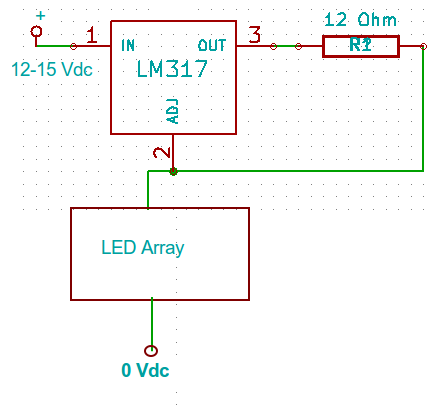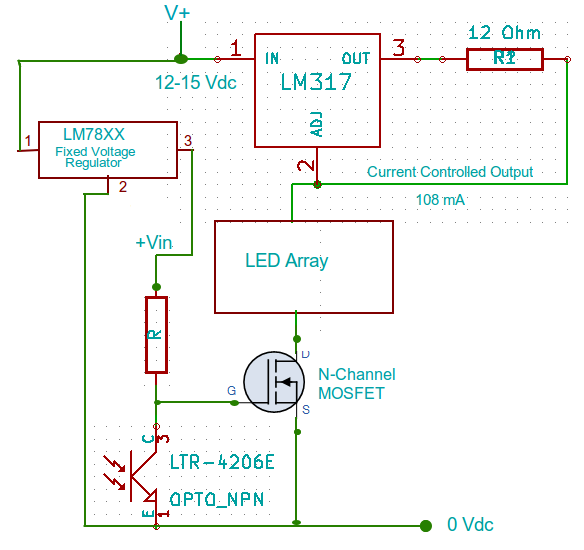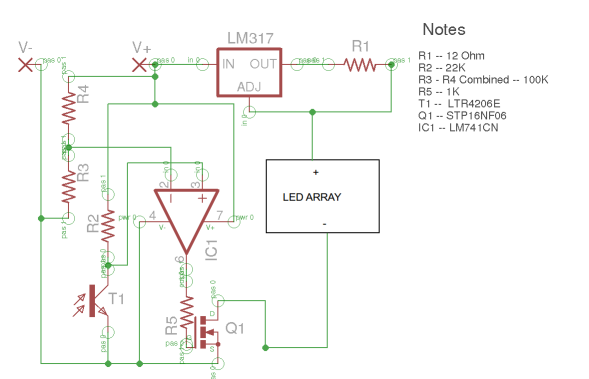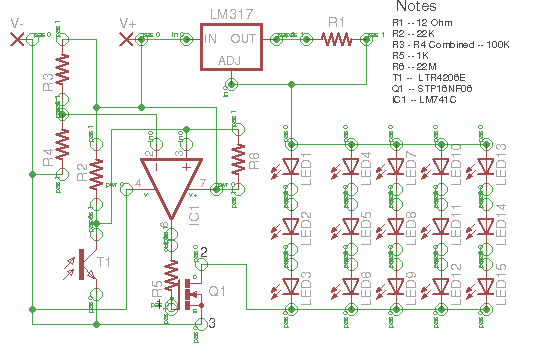What we have is a fairly straight forward LED array that is being driven by a LM317 for current regulation. Source voltage ranges between 12-15 Vdc. The array housing which also will contain the electronics components is physically quite small (not by silicon standards, but everything is relative) with a volume of about 2.5 cubic inches. Power usage should be at an absolute minimum while being able to supply the required light output and pattern. As the entire housing will be filled with potting, heat generated by non-optimal component selection could present issues.
The basic array setup has proven simple, and several acceptable working prototypes have been build as below. The LM317 is set up for current regulation at 108 mA, and excess heat has not been an issue at this point. While voltage source will vary considerably over time, it is true DC, not cleaned up AC.

The next step in the project requires the integration of switch to control the above circuit, ie: Off at dawn, on at dusk. I have researched the options extensively but have run up against a number of issues which I am unable to resolve.
1. LDR or Phototransistor as detector?
2. Component cost and complexity exceeds build requirements.
3. Large variations in circuit parameters, none of which meet my build requirements and little additional info on modifying components to suit different voltages, loads, etc.
4. Use of electro-mechanical relays.
5. Lack of personal knowledge, and a good "Okie Inventory" of spare/used parts for experimentation. Need to whip up a jig out of some 3/8 304SS bar stock... got ya covered. Dig up some mosfets and a dozen various resistors? Not so much..
In particular light of issue #5 I have to do my engineering on paper before commiting to ordering parts. 100 mile round trip to the closest location I might find what I need, so Mouser is my friend. After some consideration I have arrived at a "plan" something like below. Justification of design parameters follows: Cad sulfide LDRs are getting harder to come by, and an IR range phototransistor has added advantage of not being as sensitive to non-solar, non-incandescent stray light at night. Mosfet "switch" should be inexpensive, and with I(d) at 108mA and a mosfet with an "on-resistance" in the range of 0.1 ohms, the power disipation should be less than 2 mW.
Not a lot of heat to get rid of. Added the LM78XX as I thunk it would be easier to create a stable voltage dependant control circuit if we had a standard voltage to start out with. Not large or expensive, but not sure of power disipation issues. Have concerns about what power the phototransistor will be passing during during daylight hours. Obviously less is better.
As I stated previously, my EE skills are somewhere between slim and none, and Slim's out of town... I figure the circuit below has an excellent chance of producing more laughs than required results as it has been cobbled up from what little I have been able to absorb during several weeks of searching for answers. The requirements for the circuit are pretty concrete, and I could use some specific concrete suggestions as to how to make it work as required. Eg: There is no part # for the mosfet. Mouser lists 3000+ thru-hole n-channel mosfets. Have a good suggestion for a part # that meets the requirements without having to sift the data-sheets? What voltage LM78xx should I use? Assume the closer I can get to the input voltage (less 1.25v) the less power dissipation I will have? Given the choice of voltage, what is a good starting value for the fixed resistance in the control circuit... and so on.

Apologies for the long winded post, but figure I am not gonna get any specific answers without information as to the requirements.
Looking forward to suggestions and/or solutions that will yield better results.



